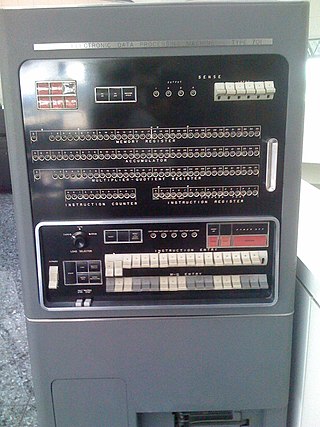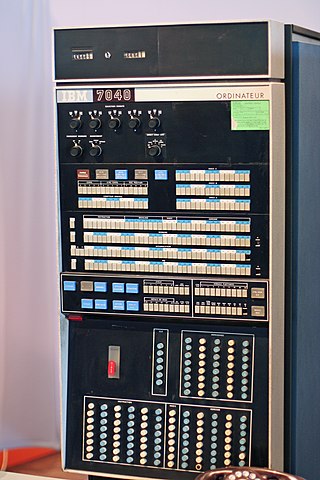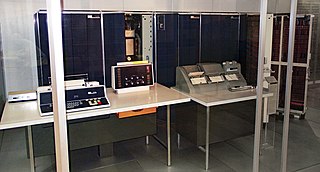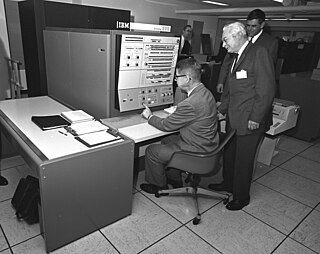Related Research Articles

Basic Operating System/360 (BOS/360) was an early IBM System/360 operating system.

The IBM 604 Electronic Calculating Punch was the world's first mass-produced electronic calculator along with its predecessor the IBM 603. It was an electronic unit record machine that could perform multiple calculations, including division. It was invented and developed by Ralph Palmer, Jerrier Haddad and Byron Phelps. It was introduced by IBM in 1948.
A stored-program computer is a computer that stores program instructions in electronically, electromagnetically, or optically accessible memory. This contrasts with systems that stored the program instructions with plugboards or similar mechanisms.

The IBM 701 Electronic Data Processing Machine, known as the Defense Calculator while in development, was IBM’s first commercial scientific computer and its first series production mainframe computer, which was announced to the public on May 21, 1952. It was designed and developed by Jerrier Haddad and Nathaniel Rochester and was based on the IAS machine at Princeton.

The IBM 7040 was a historic but short-lived model of transistor computer built in the 1960s.

Gerrit Anne "Gerry" Blaauw was a Dutch computer scientist, known as one of the principal designers of the IBM System/360 line of computers, together with Fred Brooks, Gene Amdahl, and others.

The IBM 702 was an early generation tube-based digital computer produced by IBM in the early to mid-1950s. It was the company's response to Remington Rand's UNIVAC, which was the first mainframe computer to use magnetic tapes. As these machines were aimed at the business market, they lacked the leading-edge computational power of the IBM 701 and ERA 1103, which were favored for scientific computing, weather forecasting, the aircraft industry, and the military and intelligence communities.

The IBM Selective Sequence Electronic Calculator (SSEC) was an electromechanical computer built by IBM. Its design was started in late 1944 and it operated from January 1948 to August 1952. It had many of the features of a stored-program computer, and was the first operational machine able to treat its instructions as data, but it was not fully electronic. Although the SSEC proved useful for several high-profile applications, it soon became obsolete. As the last large electromechanical computer ever built, its greatest success was the publicity it provided for IBM.

IBM 7070 is a decimal-architecture intermediate data-processing system that was introduced by IBM in 1958. It was part of the IBM 700/7000 series, and was based on discrete transistors rather than the vacuum tubes of the 1950s. It was the company's first transistorized stored-program computer.
Speedcoding, Speedcode or SpeedCo was the first high-level programming language created for an IBM computer. The language was developed by John W. Backus in 1953 for the IBM 701 to support computation with floating point numbers.

CP-40 was a research precursor to CP-67, which in turn was part of IBM's then-revolutionary CP[-67]/CMS – a virtual machine/virtual memory time-sharing operating system for the IBM System/360 Model 67, and the parent of IBM's VM family. CP-40 ran multiple instances of client operating systems – particularly CMS, the Cambridge Monitor System, built as part of the same effort. Like CP-67, CP-40 and the first version of CMS were developed by IBM's Cambridge Scientific Center (CSC) staff, working closely with MIT researchers at Project MAC and Lincoln Laboratory. CP-40/CMS production use began in January 1967. CP-40 ran on a unique, specially modified IBM System/360 Model 40.
James Wares Bryce was an American engineer and inventor. In 1936, on the centenary of the United States Patent Office, he was honored as one of the country’s 10 greatest living inventors.
James Hartwell Frame was a computer pioneer who worked to standardize software development from the more idiosyncratic form of its unstructured early days into a predictable and manageable methodology. He spent the majority of his career with IBM, eventually being recruited by ITT Corporation. Later, he founded a consulting business, James Frame Enterprises.
The IBM 608 Transistor Calculator, a plugboard-programmable unit, was the first IBM product to use transistor circuits without any vacuum tubes and is believed to be the world's first all-transistorized calculator to be manufactured for the commercial market. Announced in April 1955, it was released in December 1957. The 608 was withdrawn from marketing in April 1959.
Input/Output Control System (IOCS) is any of several packages on early IBM entry-level and mainframe computers that provided low level access to records on peripheral equipment. IOCS provides functionality similar to 1960s packages from other vendors, e.g., File Control Processor (FCP) in RCA 3301 Realcom Operating System, GEFRC in GECOS, and to the later Record Management Services (RMS) in DEC VAX/VMS
The IBM 7701 Magnetic Tape Transmission Terminal was a communications device announced by IBM in 1960. It was designed to transfer the contents of a reel of magnetic tape over a leased or dial telephone circuit.
The IBM 1009 Data Transmission Unit was an IBM communications controller introduced in 1960. The 1009 used the Synchronous transmit-receive (STR) protocol to transfer data at 150 characters per second (cps) over a single point-to-point dial or leased telephone line. The system was advertised as being able to "link the magnetic core memories of IBM 1401 computers over telephone lines."

The IBM System/360 Model 40 was a mid-range member of the IBM System/360 family. It was announced on April 7, 1964, shipped in 1965, and withdrawn on October 7, 1977.
Attached Support Processor (ASP) was an implementation of loosely coupled multiprocessing for IBM's OS/360 operating system. IBM later changed the name to Asymmetrical multiProcessor but retained the acronym ASP.

The IBM System/360 Model 85 is a high-end member of the System/360 family of computers, with many advanced features, and was announced in January 1968 and first shipped in December 1969. IBM built only about 30 360/85 systems because of "a recession in progress".
References
- ↑ American Men of Science: A Biological Directory, The Physical and Biological Sciences, Supplement 4, edited by The Jaques Cattell Press, Eleventh Edition. R.R. Bowker Company. New York & London. 1968. p. 520.
- ↑ Charles J. Bache, Lyle R. Johnson, John H. Palmer, and Emerson W. Pugh, IBM's Early Computers. The MIT Press. 1986. p. 48-49.
- ↑ American Men of Science: A Biological Directory, The Physical and Biological Sciences, Supplement 4, edited by The Jaques Cattell Press, Eleventh Edition. R.R. Bowker Company. New York & London. 1968. p. 520.
- ↑ American Men of Science: A Biological Directory, The Physical and Biological Sciences, Supplement 4, edited by The Jaques Cattell Press, Eleventh Edition. R.R. Bowker Company. New York & London. 1968. p. 520.
- ↑ Charles J. Bache, Lyle R. Johnson, John H. Palmer, and Emerson W. Pugh, IBM's Early Computers. The MIT Press. 1986. p. 48-49.
- ↑ Charles J. Bache, Lyle R. Johnson, John H. Palmer, and Emerson W. Pugh, IBM's Early Computers. The MIT Press. 1986. p. 48, p. 612n32.
- ↑ Emerson William Pugh, Lyle R. Johnson, John H. Palmer, IBM's 360 and Early 370 Systems. The MIT Press. 1991. p. 681.
- ↑ Mary Ellen Thomsen, "Typist's Dream" in Harvard Alumni Bulletin, January 14, 1956.
- ↑ Mary Ellen Thomsen, "Typist's Dream" in Harvard Alumni Bulletin, January 14, 1956.
- American Men of Science: A Biological Directory, The Physical and Biological Sciences, Supplement 4, edited by The Jaques Cattell Press, Eleventh Edition. R.R. Bowker Company. New York & London. 1968. p. 520.
- Mary Ellen Thomsen, "Typist's Dream" in Harvard Alumni Bulletin, January 14, 1956.
- Charles J. Bache, Lyle R. Johnson, John H. Palmer, and Emerson W. Pugh, IBM's Early Computers. MIT Press. 1986.
- Emerson William Pugh, Lyle R. Johnson, John H. Palmer, IBM's 360 and Early 370 Systems. MIT Press. 1991. p. 681.